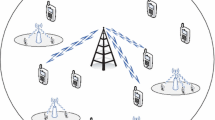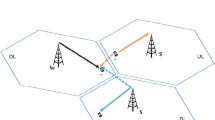Abstract
Femtocell is an efficient solution for mobile operators to expand indoor coverage and increase network capacity. In this paper, we study the downlink resource allocation problem of two-tier macrocell–femtocell networks. We first formulate the problem as a Mixed Integer Non-Linear Program (MINLP) which aims to maximize the capacity of clustered femtocell networks subject to hard delay constraints of flows with different priorities. Next, we build \((\rho (\theta ),\sigma (\theta ))\) arrival model for the traffics and apply Stochastic Network Calculus (SNC) to transforming the delay constraints into alternative minimum transmission rate requirements, then we propose a resource allocation algorithm called S-SAPCS to solve the MINLP. Simulation results show that the proposed algorithm has near-optimal performance. We also design a scheme based on deterministic network calculus to show that S-SAPCS is able to exploit the statistical multiplexing gain among multiple flows, which improves the throughput significantly.




Similar content being viewed by others
References
Abdelnasser A, Hossain E (2013) Subchannel and power allocation schemes for clustered femtocells in two-tier OFDMA hetnets. In: Communications Workshops (ICC), 2013 IEEE international conference on, pp 1129–1133. doi:10.1109/ICCW.2013.6649406
Ali N, Taha A, Hassanein H (2013) Quality of service in 3GPP r12 LTE Adv 51(8):103–109. doi:10.1109/MCOM.2013.6576346. http://ieeexplore.ieee.org/stamp/stamp.jsp?arnumber=6576346
Anderson E, Phillips C, Sicker D, Grunwald D (2014) Optimization decomposition for scheduling and system configuration in wireless networks 22(1):271–284. doi:10.1109/TNET.2013.2289980. http://ieeexplore.ieee.org/stamp/stamp.jsp?arnumber=6684595
Arslan M, Yoon J, Sundaresan K, Krishnamurthy S, Banerjee S (2013) A resource management system for interference mitigation in enterprise OFDMA femtocells. IEEE/ACM Trans Netw 21(5):1447–1460. doi:10.1109/TNET.2012.2226245
Azodolmolky S, Wieder P, Yahyapour R (2013) Performance evaluation of a scalable software-defined networking deployment. In: Software defined networks (EWSDN), 2013 Second European Workshop on, IEEE pp 68–74
Capozzi F, Piro G, Grieco LA, Boggia G, Camarda P (2012) A system-level simulation framework for lte femtocells. In: Proceedings of the 5th international ICST conference on simulation tools and techniques, pp 211–213. ICST (Institute for Computer Sciences, Social-Informatics and Telecommunications Engineering). http://dl.acm.org/citation.cfm?id=2263049
Ciucu F, Burchard A, Liebeherr J (2005) A network service curve approach for the stochastic analysis of networks. In: Proceedings of the 2005 ACM SIGMETRICS international conference on measurement and modeling of computer systems, SIGMETRICS ’05, pp 279–290. ACM, New York, NY, USA. doi:10.1145/1064212.1064251
Doumi TL, Dolan MF, Tatesh S, Casati A, Tsirtsis G, Anchan K, Flore D (2013) Lte for public safety networks. IEEE Commun Mag 51(2):106–112
Egilmez H, Civanlar S, Tekalp A (2013) An optimization framework for QoS-enabled adaptive video streaming over openflow networks 15(3):710–715. doi:10.1109/TMM.2012.2232645. http://ieeexplore.ieee.org/stamp/stamp.jsp?arnumber=6376227
Fan L, Wang Y, Cheng X, Li J, Jin S (2015) Privacy theft malware multi-process collaboration analysis. Secur Commun Netw 8(1):51–67
Fan L, Wang Y, Jin X, Li J, Cheng X, Jin S (2013) Comprehensive quantitative analysis on privacy leak behavior. PLoS One 8(9):e73,410. doi:10.1371/journal.pone.0073410
Fidler M (2006) An end-to-end probabilistic network calculus with moment generating functions. In: Quality of service, 2006. IWQoS 2006. 14th IEEE international Workshop on, pp 261–270
Gharehshiran O, Attar A, Krishnamurthy V (2013) Collaborative sub-channel allocation in cognitive LTE femto-cells: a cooperative game-theoretic approach. IEEE Trans Commun 61(1):325–334. doi:10.1109/TCOMM.2012.100312.110480
Hosseinimotlagh S, Khunjush F, Samadzadeh R (2015) Seats: smart energy-aware task scheduling in real-time cloud computing. J Supercomput 71(1):45–66
Ji W, Chen B, Chen Y, Kung S (2015) Profit improvement in wireless video broadcasting system: a marginal principle approach 14(8):1659–1671. doi:10.1109/TMC.2014.2362919. http://ieeexplore.ieee.org/stamp/stamp.jsp?arnumber=6935007
Jiang Y (2006) A basic stochastic network calculus. In: Proceedings of ACM SIGCOMM Conference, October 2006, pp 123–134. doi:10.1145/1159913.1159929. http://dl.acm.org/citation.cfm?
Jiang Y (2010) A Note on Applying Stochastic Network Calculus[C]. In: Proceedings of SIGCOMM’10, Pisa, Italy, pp 16–20
Li C, Burchard A, Liebeherr J (2007) A network calculus with effective bandwidth. IEEE/ACM Trans Netw (TON) 15(6):1442–1453
Lien SY, Lin YY, Chen KC (2011) Cognitive and game-theoretical radio resource management for autonomous femtocells with QoS guarantees 10(7):2196–2206. doi:10.1109/TWC.2011.060711.100737. http://ieeexplore.ieee.org/stamp/stamp.jsp?arnumber=5898374
Lin C, Liu Y, Tao M (2013) Cross-layer optimization of two-way relaying for statistical qos guarantees. IEEE J Sel Areas Commun 31(8):1583–1596
Liu H, Popovski P, de Carvalho E, Zhao Y (2013) Sum-rate optimization in a two-way relay network with buffering 17(1):95–98. doi:10.1109/LCOMM.2012.112012.122101. http://ieeexplore.ieee.org/stamp/stamp.jsp?arnumber=6362133
Lopez-Perez D, Chu X, Vasilakos A, Claussen H (2014) Power minimization based resource allocation for interference mitigation in OFDMA femtocell networks 32(2):333–344. doi:10.1109/JSAC.2014.141213. http://ieeexplore.ieee.org/stamp/stamp.jsp?arnumber=6514950
Lu Z, Sun Y, Wen X, Su T, Ling D (2012) An energy-efficient power control algorithm in femtocell networks. In: Computer science and education (ICCSE), 2012 7th international conference on, pp 395–400
Mhiri F, Sethom K, Bouallegue R (2013) A survey on interference management techniques in femtocell self-organizing networks. J Netw Comput Appl 36(1):58–65
Morita M, Matsunaga Y, Hamabe K (2010) Adaptive power level setting of femtocell base stations for mitigating interference with macrocells. In: Vehicular technology conference fall (VTC 2010-Fall), 2010 IEEE 72nd, pp 1–5. doi:10.1109/VETECF.2010.5594572. http://ieeexplore.ieee.org/stamp/stamp.jsp?arnumber=5594572
Ngo DT, Khakurel S, Le-Ngoc T (2014) Joint subchannel assignment and power allocation for OFDMA femtocell networks 13(1):342–355. doi:10.1109/TWC.2013.111313.130645
Olariu C, Fitzpatrick J, Perry P, Murphy L (2012) A QoS based call admission control and resource allocation mechanism for LTE femtocell deployment. In: Consumer Communications and networking conference (CCNC), 2012 IEEE, pp 884–888. doi:10.1109/CCNC.2012.6181184. http://ieeexplore.ieee.org/stamp/stamp.jsp?arnumber=6181184
Rosensweig EJ, Kurose J (2013) A network calculus for cache networks. In: INFOCOM, 2013 proceedings IEEE, pp 85–89
Taleb T, Ksentini A (2012) QoS/qoe predictions-based admission control for femto communications. In: Communications (ICC), 2012 IEEE international conference on, pp 5146–5150. doi:10.1109/ICC.2012.6364289. http://ieeexplore.ieee.org/stamp/stamp.jsp?arnumber=6364289
Valls JJ, Ros A, Sahuquillo J, Gomez ME (2015) Ps-cache: an energy-efficient cache design for chip multiprocessors. J Supercomput 71(1):67–86
Wang W, Yu G, Huang A (2013) Cognitive radio enhanced interference coordination for femtocell networks 51(6):37–43. doi:10.1109/MCOM.2013.6525593. http://ieeexplore.ieee.org/stamp/stamp.jsp?arnumber=6525593
Wang Y (2013) On deriving stable backlog bounds by stochastic network calculus. In: Teletraffic Congress (ITC), 2013 25th International, IEEE pp 1–8
Xiang J, Zhang Y, Skeie T, Xie L (2010) Downlink spectrum sharing for cognitive radio femtocell networks. Syst J IEEE 4(4):524–534
Zhang S, Ji W, Chen BW, Chen Y (2014) Research on cooperative video transmission over heterogeneous devices based on game theory. In: Game theory for networks (GAMENETS), 2014 5th international conference on, pp 1–5. doi:10.1109/GAMENETS.2014.7043731. http://ieeexplore.ieee.org/stamp/stamp.jsp?arnumber=7043731
Author information
Authors and Affiliations
Corresponding author
Additional information
This work is supported by the National Natural Science Foundation of China (NSFC) under Grant No. 61370065, the National Science and Technology Pillar Program (2015BAK12B00), and the Project of Construction of Innovative Teams and Teacher Career Development for Universities and Colleges Under Beijing Municipality (IDHT20130519).
Rights and permissions
About this article
Cite this article
Chen, X., Si, Y. & Xiang, X. Delay-bounded resource allocation for femtocells exploiting the statistical multiplexing gain. J Supercomput 71, 3217–3236 (2015). https://doi.org/10.1007/s11227-015-1494-9
Published:
Issue Date:
DOI: https://doi.org/10.1007/s11227-015-1494-9




